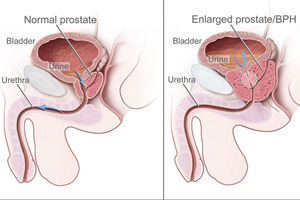What are the symptoms of an enlarged prostate and how is it treated?

An enlarged prostate is often called benign prostatic hyperplasia (BPH).
The publicity surrounding King Charles' health has brought renewed attention to a rather unspoken problem that affects millions of men worldwide: an enlarged prostate.
Data from the National Institute of Diabetes and Digestive and Kidney Diseases (NIDDK) suggests that 50 per cent of men over 50 and 90 per cent of those over 80 will have some degree of prostate enlargement.
While there are no readily available studies focusing solely on Kenya, research conducted in areas such as Kamuli District in Uganda suggests a prevalence of prostate enlargement of almost 48 per cent in men aged 50 and over.
But questions remain. From what it is to whether it means prostate cancer. Dr Gitobu Mburugu, a consultant urologist at Kenyatta National Hospital (KNH), offers some insight.
What exactly is the prostate gland and where is it located?
The prostate is a heart-shaped, walnut-shaped or pear-shaped organ that is located in the male pelvis just below the bladder and surrounds the urethra as it leaves the bladder - it is located just in front of the rectum.
Among other things, the gland produces chemicals such as zinc, prostaglandins (a group of lipids) and nutrients that help sperm become active after ejaculation and enable them to fulfil their function of fertilising an egg.
Why does the prostate often grow with age?
We do not know exactly why the prostate grows with age, but it is linked to the decline in the male hormone testosterone and the increase in female hormone levels in ageing men, which can cause prostate cells to live longer and multiply.
What does a normal prostate look like and what does an enlarged prostate look like?
A normal prostate is about the size of a plum, and as it grows it can become as large as a passion fruit. An enlarged prostate can be completely asymptomatic, but in some people it can cause what are known as lower urinary tract symptoms, such as frequent urination both day and night, a weak, prolonged stream of urine, urgency, a feeling of fullness in the bladder.
It can also lead to complications such as recurrent urinary bleeding, recurrent urinary infections, blockage of urine flow, bladder stone formation due to infection and incomplete bladder emptying, or kidney damage due to urine backflow.
Does the size of the gland matter, or do all men have the same size gland?
Men have a small prostate measuring 15 to 25 grams until they are about 40 years old, then it can start to grow at different rates for different men. Some may not grow much, others may grow to 200 grams or more. The rate of growth is not proportional to the discomfort it causes a man: some small prostates can cause very bothersome lower urinary tract symptoms, and some large prostates may not cause many symptoms, and vice versa.
Can an enlarged gland be seen?
It cannot be seen, except during surgery, but it can be felt with a finger inserted into a man's rectum. It weighs about 15 to 20 grams in a young man, but it starts to grow after the age of 40. It can be seen on ultrasound, CT or MRI scans.
Is an enlarged prostate a clear sign of prostate cancer?
No. The enlargement is benign and has nothing to do with prostate cancer, which is a separate process. Benign means that it will not spread to other parts of the body. However, because prostate cancer occurs in older men, the prostate is usually already enlarged. Benign enlargement mainly just causes a reduction in quality of life and bothers a man because of the troublesome lower urinary tract symptoms already described in my earlier article.
Occasionally, enlargement can cause serious health problems due to bleeding from an enlarged prostate, urinary infections, bladder stones, kidney failure due to blockage of urine flow, or complete inability to pass urine.
Again, benign prostate enlargement is not and does not lead to cancer, contrary to what some people think.
Are there any drugs that can help?
There are medications to relieve prostate symptoms called alpha blockers, which work by relaxing the prostate muscle, and others called 5 alpha reductase inhibitors, which reduce the size of the prostate. Others, called anti-muscarinics, relax the bladder and reduce urinary frequency and urgency. Finally, if the medications do not work, or if complications described above occur, the prostate may be reduced by surgery.
How often should men be screened and at what age should they start?
Prostate cancer screening using a blood test called prostate-specific antigen (PSA) should start at age 40 to 45 and is done annually. PSA is a protein produced by the prostate gland.





